The photographs on this page illustrate key poses for balancing our hormones, relieving stress, supporting pelvic health and replenishing our energy reserves during all the stages of life. These poses are vital for both men and women at midlife and beyond, especially as we face the many changes that life brings.

balancing the endocrine system.
Photo Credit: Radames Pera. Model: Marsha Mann
Click here: Seven Essential Poses for Crossing the Menopausal Bridge
(Article by Suza Francina, adapted from her book, Yoga and the Wisdom of Menopause)
For easy reference, here is a list of the key poses for pre and post menopause that are suitable for beginners. Stay as long as you like in each pose. If you are tired and have only ten minutes, I recommend Supported Legs Up the Wall Pose, which brings your heart below the level of your legs. This in itself is restful and will help replenish your energy reserves.
1.Child’s Pose (Adho Mukha Virasana)
2.Downward- Facing Dog Pose (Adho Mukha Svanasana)
3.Seated Bound Angle Pose (Baddha Konasana) (not shown)
4.Seated Wide Angle Pose (Upavistha Konasana) (not shown)
5.Supported (Elevated) Legs Up the Wall Pose (Viparitta Karani
6.Supported Bridge Pose (Setu Bandha Sarvangasana)
7.Supported Lying Down (Reclining) Bound Angle Pose (Supta Baddha Konasana)
8.Deep Relaxation Pose/Corpse Pose (Savanasa)
One more note: Standing Forward Bends practiced with props, being careful to bend from the hip-hinge with the spine elongated, and other Standing Poses either with back to the wall or facing the wall, are also highly recommended during menopause and other times of transition. Weight-bearing poses are vital for keeping our bones strong and healthy. (See sources at end of this page.)
Photos by Ruth Miller from Suza’s book, Yoga and the Wisdom of Menopause. Models: Catherine Meek, Suza Francina, Marsha Mann
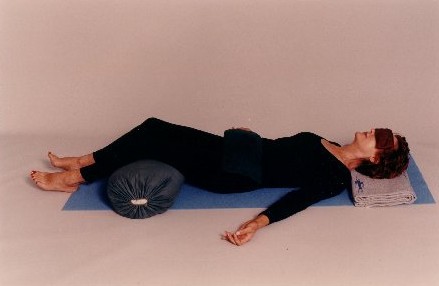
You may want to begin your practice with a few minutes (or longer) in Deep Relaxation Pose with a bolster or folded blanket under your legs, to relax the body, soothe the nervous system and quiet the mind. (Or begin with Supported Deep Relaxation Pose, shown at the end of this sequence.)
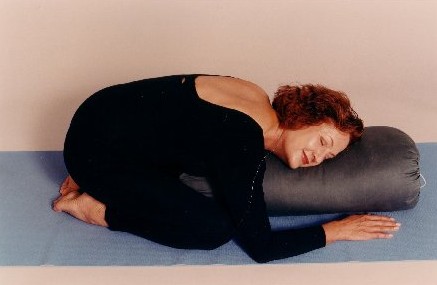
Supported Child’s Pose. A restful pose to help calm your nerves and relax your back. Good to practice before and after Downward Facing Dog Pose.
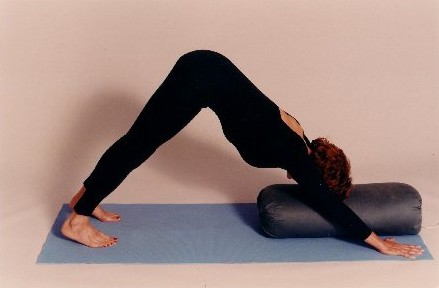
Supported Downward Facing Dog Pose: Menopause Medicine! If your body is very stiff, or you have wrist or shoulder problems, your teacher can show you how to practice the pose in a way that is right for you. This is a key weight-bearing pose for strong, healthy bones.
Relax again in Child’s Pose, with or without support, after Downward Facing Dog Pose.
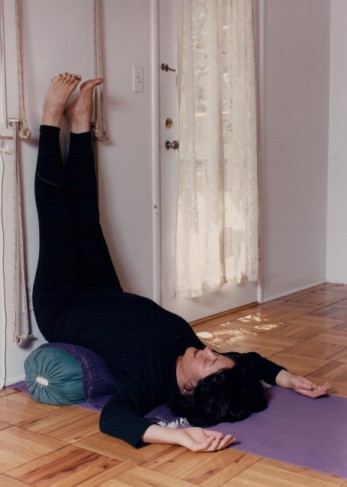
Supported Legs Up the Wall Pose –Yoga’s Great Rejuvenator
a key pose for replenishing your adrenal reserves. If I had to pick two poses to practice during menopause every single day for at least ten minutes, it would be this pose and Supported Bound Angle Pose.
Note: Beginners are often more comfortable with one or two folded blankets, instead of a bolster. Or simply relax with your legs up the wall, a folded blanket under your head. If you cannot get comfortable with the legs straight up, try moving a few inches away from the wall and bending your knees. Or relax with your lower legs over the seat a chair.
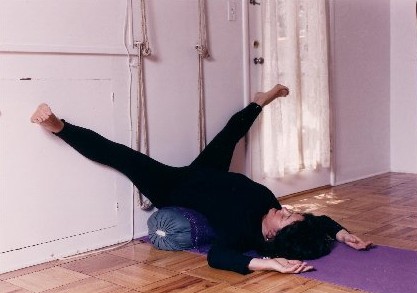
Legs Up the Wall Pose with Feet Wide Apart–Refreshing and relaxing.
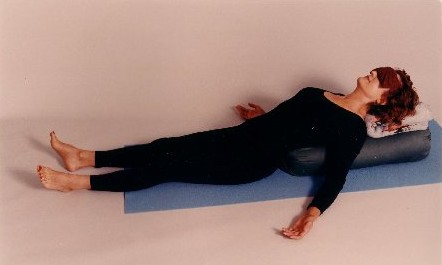
Supported Bridge Pose –The “Menopausal Bridge Pose”.
a restful pose for the heart, mind and nervous system. If you feel strain in your back in Bridge Pose, try practicing the pose with knees bent, feet on floor on either side of the bolster. You can also place the lower bolster horizontally under your feet, so that the two bolsters form a “T” shape. The soles of the feet can also be together, as in Lying Down Bound Angle Pose, on top of the bolster. A teacher can show you how to adjust the height and placement of the bolsters and folded blankets in this pose
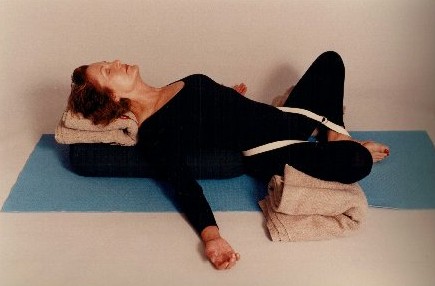
Supported Lying Down Bound Angle Pose, The “Goddess Pose.” From the Goddess Pose, straighten your legs and go directly into Supported Deep Relaxation Pose,

Supported Deep Relaxation Pose –The Pause That Refreshes During the Pause. Helps remove depression and mental and physical fatigue. (Note: Beginners may prefer to practice lying flat, as shown below, with a bolster under your knees.)

Deep Relaxation Pose with Bolster Under the Legs– to relax the body, soothe the nervous system and bring peace to the mind.
For experienced students, more Key Poses for Women at Midlife and Beyond
Learn to practice these poses under the guidance of a knowledgeable teacher.

Supported Shoulderstand with Chair, a key pose for pelvic health, cooling hot flashes and balancing the endocrine system.
Photo Credit: Radames Pera. Model: Marsha Mann
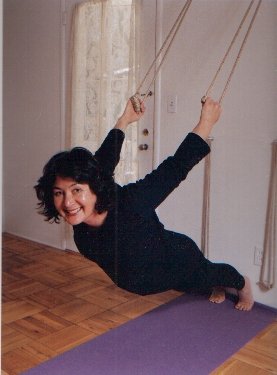
Yoga Wall Ropes– An Investment in Your Health for Years to Come. Yoga Wall Ropes are the antidote for the stiffness that tends to settle into the body during menopause. They stretch and strengthen the whole body and tone pelvic and abdominal organs.
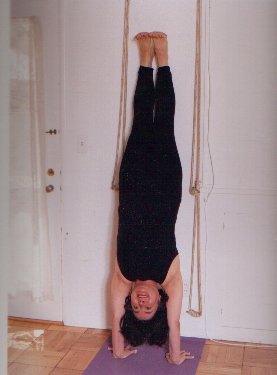
Handstands strengthen the bones of the upper body and help prevent osteoporosis.
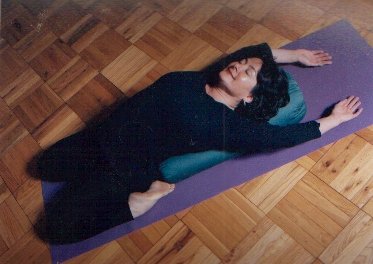
Supported Lying Down Heroine Pose — opens the chest and is particularly beneficial for the health of the heart. Also stretches the abdomen and aids digestion. Helps relieve discomfort and stiffness in the legs and feet.
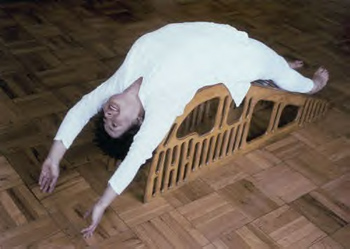
Supported Backbends such as lying back over a back bender help recharge the adrenal glands and replenish energy reserves during menopause. Backbends open the chest, lengthen the spine and strengthen the cardiovascular system. They help lift our spirits and give a feeling of inner joy and happiness.
Sources and Recommended Reading:
Francina, Suza. Yoga and the Wisdom of Menopause, A Guide to Physical, Emotional and Spiritual Health at Midlife and Beyond. Health Communications, Inc. 2003
Lasater, Judith Hanson, Ph.D., P.T., Relax and Renew: Restful Yoga for Stressful Times. Rodmell Press, 1995
Sparrowe, Linda, and Patricia Walden. The Women’s Book of Yoga and Health: A Lifelong Guide to Wellness. Shambhala, 2002